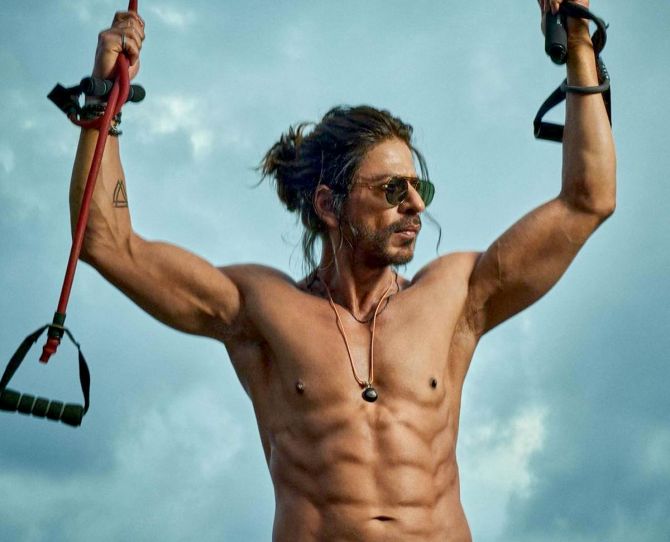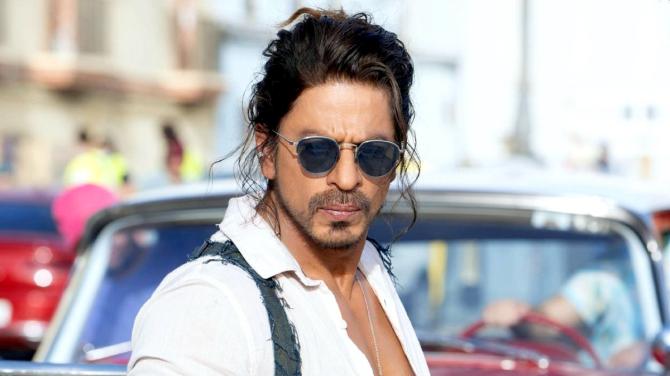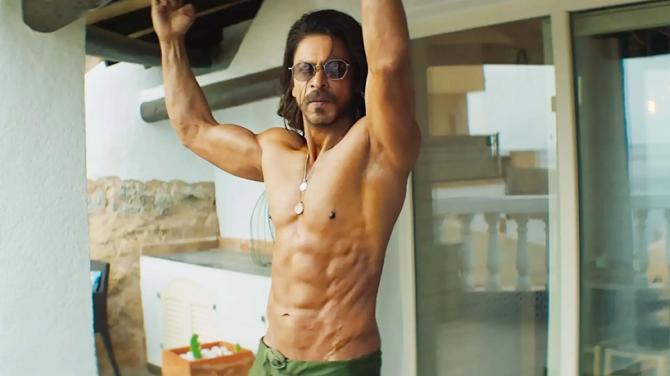Shah Rukh had outgrown the roles that made him a star -- the menacing, obsessive lover in Darr, the regular guy in Kabhi Haan Kabhi Na or the new age boyfriend in Dilwale Dulhania Le Jayenge.
By the time he entered his 50s, he was struggling to find his feet, explains Vanita Kohli-Khandekar.

Shah Rukh Khan, 57, is tasting success after a long time.
His latest release, Siddharth Anand's Pathaan (Yash Raj Films), a stylish spy thriller has grossed over Rs 500 crore (Rs 5 billion) at the domestic box-office.
Pathaan comes after a string of unsuccessful Shah Rukh films -- Fan (2016), Jab Harry Met Sejal (2017) and Zero (2018).
His body of work spans more than 100 films. Many of these -- Dilwale Dulhania Le Jayenge, Kuch Kuch Hota Hai, Om Shanti Om, Chak De India -- are not just cult films but also among the biggest grossers in Indian cinema.
A hit here and a flop there shouldn't have mattered. But tongues had begun wagging about his fading stardom.
Khan, who was 53 then, withdrew into himself to figure things out. Then Covid struck.
As a result, for four years, one of India's biggest stars and the man whose fanbase is estimated at 3.5 billion people by Time magazine, was not seen on the big screen except in cameos.
His resurrection as an action hero gives rise to two questions that fascinate me.
Why do superstars flounder professionally in their 50s? And is there a formula to their resurrection?

Some of India's biggest stars -- Ashok Kumar, Dilip Kumar, Rajesh Khanna, Amitabh Bachchan -- all struggled professionally in their 50s.
Dilip Kumar was the heart-throb of an entire generation with hits like Uran Khatola (1955), Naya Daur (1957), Madhumati (1958) and Mughal-e-Azam (1960), among others.
Yet the moment he entered his 50s, he gave some of his biggest flops such as Sagina (1974) and Bairaag (1976).
Bachchan is the man who gave us hits like Sholay and Deewar in the 1970s. By his late 40s though he struggled to look convincing in the very forgettable Shahenshah or Ganga Jamuna Saraswati (1988).
This is true for female superstars too. The only difference is it hits women in their late 30s, early 40s.
Some of the reasons can be found in cinema history.
Soon after he made the first Indian feature film, Raja Harishchandra, in 1913, Dhundiraj Govind 'Dadasaheb' Phalke set up the Hindustan Film Cinema Company.
Others followed and soon India had film studios. They hired writers, lyricists, actors and actresses and churned out several films a year.
Dilip Kumar, Ashok Kumar, Dev Anand were all studio employees drawing a fixed salary.
Since they made several films a year, studios mitigated the risk inherent in the business of cinema.
The talent was insulated from it. By the mid-1940s many financiers, bloated with Second World War profits, tried to launder their money through the studio system.
Star salaries and budgets got bigger, stars and writers were being poached. The studio system started breaking up.
The result: The risk shifted from the studios to producers. The pressure on each film to make money went up.
To make money a film had to run for as long as possible in 1,000-seater halls.
In this ecosystem, the individual star became more important than the story, the script or the writer. He brought in the financiers and audience both.
It is in this period that Dilip Kumar entered his 50s and Bachchan became the 'one-man industry'.
It was critical to have him in the film for distributors to advance money and people to walk into the theatre.
Some of the others to hit the same levels of stardom were Rajesh Khanna, Rajinikanth and Shah Rukh Khan.
The creative ecosystem was trying to mitigate risk by flogging formula and a saleable star.
Dilip Kumar became the tragedy king, Bachchan was the angry young man. No producer dared to do anything too different with them.

They were well past their 50s when writers continued to pair them with women who looked way younger on screen.
By the 1980s, cable television and video came and options increased. Bachchan had aged and he struggled.
When Sameer Nair, then programming chief at Star TV took Kaun Banega Crorepati to him early in 2000, Bachchan was at his lowest.
For a star of his stature, television was at that time thought to be a comedown. But Bachchan bit the bullet and KBC revived his career. He was 57, the same age that Shah Rukh is today.
What happened to Bachchan and Dilip Kumar is exactly what is happening to Shah Rukh Khan.
The film business is now sufficiently de-risked, but two-thirds of its revenues still come from the box-office.
If a star doesn't work there, he doesn't work anywhere else.
Shah Rukh had outgrown the roles that made him a star -- the menacing, obsessive lover in Darr, the regular guy in Kabhi Haan Kabhi Na or the new age boyfriend in Dilwale Dulhania Le Jayenge.
By the time he entered his 50s, he was struggling to find his feet. Like television resurrected Bachchan, action has become a comeback vehicle for Khan.
"Action heroes survive (the scourge of the 50s)," Chennai-based film expert Sreedhar Pillai had told me some years ago. He reasoned that Southern superstars like Chiranjeevi, Rajinikanth or others like Akshay Kumar and Salman Khan are more action-oriented, and therefore did not have the same issue. But that doesn't explain why Bachchan, the original action hero, struggled.
Then, there is Aamir Khan. In his late 30s, he cut back to one film every two-three years.
He works hard on each and has refused to get typecast.
In the process he has given us gems like Lagaan, Dangal and Taare Zameen Par. He has also completely avoided the 50s trap. Not everybody can.
Feature Presentation: Rajesh Alva/Rediff.com











